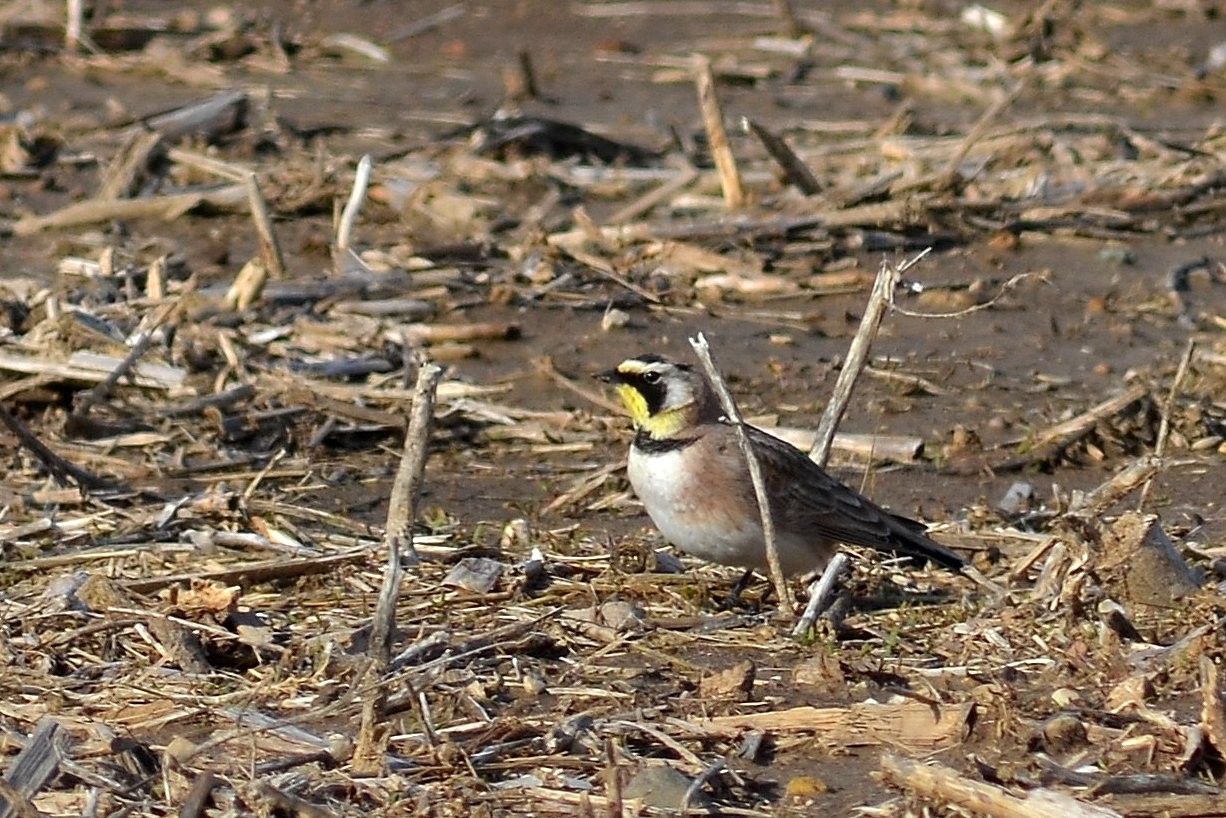Horned Lark
A species of Horned Larks Scientific name : Eremophila alpestris Genus : Horned Larks
Horned Lark, A species of Horned Larks
Botanical name: Eremophila alpestris
Genus: Horned Larks
Content
Description People often ask General Info
Description
Unlike most other larks, this is a distinctive-looking species on the ground, mainly brown-grey above and pale below, with a striking black and yellow face pattern. Except for the central feathers, the tail is mostly black, contrasting with the paler body; this contrast is especially noticeable when the bird is in flight. The summer male has black "horns", which give this species its American name. North America has a number of races distinguished by the face pattern and back colour of males, especially in summer. The southern European mountain race E. a. penicillata is greyer above, and the yellow of the face pattern is replaced with white. Measurements: Length: 6.3-7.9 in (16-20 cm) Weight: 1.0-1.7 oz (28-48 g) Wingspan: 11.8-13.4 in (30-34 cm) Vocalizations are high-pitched, lisping or tinkling, and weak. The song, given in flight as is common among larks, consists of a few chips followed by a warbling, ascending trill. 
Size
18-20 cm (7-8 in)
Colors
Black
Yellow
Bronze
Gray
White
Life Expectancy
8 years
Nest Placement
Ground
Clutch Size
2 - 5 eggs
Incubation Period
1 - 3 broods
Number of Broods
11 - 12 days
Nestling Period
8 - 10 days
Feeding Habits
Horned Lark primarily consume seeds and insects, with a preference for grasshoppers, beetles, and caterpillars. During nestling phase, insect intake increases, providing essential protein for growth. They forage on the ground and occasionally feed on plant-harbored seeds or sprouting crops.
Habitat
Horned Lark inhabits open areas with minimal vegetation, including arctic tundra, alpine zones, and human-altered spaces like farmlands. They favor terrains with sparse, short grasses and are sedentary in warm regions but migrate from colder northern areas in winter. Their adaptable nature allows them to thrive in diverse environments and forage in snow-free zones.
Nest Behavior
Female horned Larks select and prepare nest sites, with no male assistance. Excavation can take days, followed by a 2-4 day nest construction period. Nesting involves laying eggs and providing parental care, but specific patterns and timing are undisclosed.
Nest Characteristics
The nest of horned Lark, typically found on bare ground, utilizes natural or excavated depressions. It's fashioned from grass, roots, and plant material, with a soft lining of down, fur, or feathers. This cup-like structure averages 3-4 inches in diameter, with an inner diameter of about 2.5 inches, and depth of around 1.5 inches.
Dite type
Granivorous
People often ask
General Info
Feeding Habits
Bird food type
Sounds
Call
Recording location: China
Song
Recording location: United States
Call
Recording location: China
Song
Recording location: China
Song
Recording location: China
Behavior
Horned Lark typically engage in pairing or small group foraging during the breeding season and join large nomadic flocks in winter, often alongside various species. Throughout the day, these birds are seen walking or running across open terrains in search of seeds and insects. Notably, males exhibit aerial singing, likely linked to courtship or territory defense. Aggressive interactions involve males defending their breeding areas with remarkable mid-air battles and ground skirmishes. As ground nesters, horned Lark employ stealth and distraction techniques to protect their nests from predators. Remarkably, they demonstrate adaptive behavior by utilizing shade to cool themselves and their young in high temperatures.
Distribution Area
The horned lark breeds across much of North America from the high Arctic south to the Isthmus of Tehuantepec, northernmost Europe and Asia and in the mountains of southeast Europe. There is also an isolated population on a plateau in Colombia. It is mainly resident in the south of its range, but northern populations of this passerine bird are migratory, moving further south in winter. This is a bird of open ground. In Eurasia it breeds above the tree line in mountains and the far north. In most of Europe, it is most often seen on seashore flats in winter, leading to the European name. In the UK it is found as a winter stopover along the coasts and in eastern England. In North America, where there are no other larks to compete with, it is also found on farmland, on prairies, in deserts, on golf courses and airports. 
Species Status
Horned Lark populations are declining according to the North American Breeding Bird Survey. In 2016, the Partners in Flight Landbird Conservation Plan detailed the Horned Lark as a “Common Bird in Steep Decline,” but the Horned Lark as of 2016 is not on the State of North America’s Birds’ Watch List. This species’ decline could be contributed to the loss of habitat due to agricultural pesticides, the disturbed sites the birds prefer reverting back to forested lands through reforestation efforts, urbanization and human encroachment as well as collisions with wind turbines. In the open areas of western North America, horned larks are among the bird species most often killed by wind turbines. In 2013, the U.S. Fish and Wildlife Service listed the subspecies streaked horned lark as threatened under the Endangered Species Act. 
Scientific Classification
Phylum
Chordates Class
Birds Order
Perching birds Family
Larks Genus
Horned Larks Species
Horned Lark 